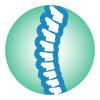Successful back pain recoveries begin with awareness and knowledge.
Start Now!
Request an Appointment Video Library
Scroll down to learn more.

Head, neck, and spine pain (especially back pain) is one of the most common causes of disability in the USA.
Nearly 80 percent of Americans have experienced low back pain at least once in their lives. Every year, there are approximately 12,000 new cases of spinal cord injuries in the US.
Our expert team at OSA provide high-quality, integrated care to every patient. At our clinic, you’re the most important person in the room. Head, neck, and spine pain can often be a discouraging and painful experience; however, help is available, and recovery is possible when you have the right team by your side. Our #1 goal is and will always be to help you get your life back.
The Anatomy of the Head, Neck, and Spine
The head:
- Your brain
- Your cranium (which holds your brain) and your scalp
- Three membranes that coat the brain and spinal cord
- Your face (eyes, ears, mouth, and nose) and your facial bones
- Cranial nerves
The neck:
- Your sternocleidomastoid (stur-noh-klie-doh-mas-toid) muscle (Push your chin to your chest. Do you feel the two muscles that push out on the front sides of your neck? That’s a single two-sided muscle.)
- Your thyroid gland (This controls your hormones and helps manage how you use energy.)
- Your parathyroid glands (These help control your body’s calcium levels.)
- Your larynx (This is also called the voice box. You also use it to let air pass through your body without choking on food or drinks.)
- Your throat
- Your trachea (or windpipe)
The back:
- Your spinal cord (nerves that run down from your neck to your lower back through a canal)
- Your vertebrae (bones that protects your spinal cord)
See More Specialties
Causes of Head, Neck, and Back Pain Conditions
- Poor posture
- Car accidents
- Sports injuries
- Daily wear and tear
- Old age
- Genetic factors
How Head, Neck, and Back Pain Conditions are Diagnosed
Your doctor will ask you various questions about your history, lifestyle, and how your symptoms affect your daily life. Your doctor will also ask about the severity of your pain. These questions can help diagnose your condition, but they also help doctors narrow down types of treatments that would be most suitable for your unique experience.
Here are some ways you can help your head, neck, or spine doctor:
- Bring all medical records, scans, and recent laboratory results to your appointment. This is very important!
- In the appointment, point to the area(s) of pain or discomfort
- Wear loose clothes to your appointment so the doctor can easily examine the area of pain.
- Tell your doctor if you have any other health problems, even if they don’t seem related to your head, neck, or back.
Many doctors will want to see what’s going on inside your body. They may order one or more of the following:
- X-rays
- MRIs
- Blood tests
- Nerve tests
- Bone scans
Surgical and Non-Surgical Treatments for Head, Neck, & Back Pain
For many patients, surgery is the last resort. In fact, many patients find that over time their pain gets better by itself or with some natural treatments. Other times, however, the pain will persist despite non-surgical and surgical treatments.
Common non-surgical treatments include:
- Physical therapy
- Massages
- Exercise
- Anesthetic creams
- Neck or back braces
- Hot and cold compresses
- Limit or remove caffeine
- Make appropriate dietary changes
- Transcranial magnetic stimulation
- Weight loss
- Medication, including opioids, muscle relaxants, and steroids
- Chiropractic treatments
- Cortisone or steroid injections
- Acupuncture
The type of surgery you receive will depend on your diagnosis. There are three main spine surgeries:
- Laminectomy. Your surgeon will remove part of the bone over the spinal column. This will relieve a pinched nerve.
- Discectomy. Your surgeon will remove part of the disc in your spine. This will also relieve nerve pressure.
- Spinal Fusion. Your surgeon will fuse two or more vertebrae together. This surgery may improve your stability, relieve pain, or fix a deformity.
Talk to your doctor if you would like to try any of these treatments for your head, neck, or back pain. He or she can provide you with more information and help monitor your progress.



